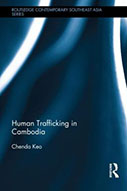Human Trafficking in Cambodia

Author: Chenda Keo
Publisher: Abingdon, UK; New York: Routledge, 2014. 240p.
Reviewer: Bernadette Barton | September 2014
Issues of human trafficking currently receive much global, national, and local attention. Trafficking is a political issue that, on the surface, unites otherwise different coalitions of groups including for example, political conservatives and liberals, and conservative Christians and some feminists. Most reading this review have likely passed roadside billboards with photos of distressed-looking women and messages saying something like, “Human Trafficking is Modern Day Slavery. Know it. See it. Report it,” with an accompanying hotline number the viewer can call. Almost everyone agrees that human trafficking is immoral, and thus anti-trafficking legislation easily gains political traction.
In the mid 1990’s the US government began focusing increased attention on trafficking. In 2000, the Bush administration passed the Trafficking Victims Protection Act (TVPA). Under this legislation, the State Department is required to produce an annual report measuring countries’ anti-trafficking efforts. Countries are classified in three tiers. Tier 1 countries are fully observant with US anti-trafficking policies, Tier 2 countries do not wholly comply but are making efforts to do so, and Tier 3 countries are non-compliant. A country’s tier ranking affects its eligibility for certain kinds of assistance. This is then a powerful motivator for state governments, like Cambodia, to enact anti-trafficking policies that improve its tier ranking.
While working as the Project Coordinator for the International Organization for Migration, Chenda Keo was assigned the task of providing technical assistance to 15 partner NGOs to help victims of human trafficking. To prepare, Keo reviewed NGO sources that painted human trafficking in stark terms, largely as a dark story of helpless victims and ruthless, violent traffickers. After reading these reports and documents, Keo believed, like most of us likely would, that trafficking was a serious social problem that needed to be urgently and effectively addressed. He began this work by interviewing 17 trafficked children, and found surprisingly, that none of them considered themselves trafficking victims. Puzzled by this finding, Keo set out to do a more comprehensive study on trafficking in Cambodia, with a special focus on the perspectives of incarcerated traffickers, and the result is this comprehensive and thoughtful text.
Keo argues that the facts (12.3 million people enslaved) and figures ($32 billion in profits for traffickers) cited by institutional authorities like NGOs are unsubstantiated as there are very few empirical studies on trafficking. To help fill this gap, Keo reviewed police and prison records, and interviewed 466 participants, including 91 individuals incarcerated for human trafficking in Cambodia. He explores five major themes in the text: who are the traffickers, how do they operate, how much profit do they make, why do they engage in trafficking activities, and how does the Cambodian Criminal Justice System adjudicate suspected and convicted traffickers.
In stark contrast to the cultural imaginary of the trafficker as a male thug with ties to organized crime, Keo found that incarcerated traffickers in Cambodia were poor, uneducated women, most operating on a very small scale. Further, he believed, and demonstrated much evidence to support the likelihood, that 59% of his incarcerated interview participants were wrongfully convicted. Of those remaining, only one had any ties to organized crime, and many of the others did not realize they were violating anti-trafficking laws. They operated individually, most out of economic desperation. They made little profit, many were unaware they were breaking the law, and those that were caught and unable to pay the requisite bribes were dealt with harshly by a corrupt Criminal Justice System.
Keo situates his findings in a push and pull model of human trafficking. The push factors he identified include elements related to systemic, institutionalized inequality such as poverty, a lack of education, unemployment, and too-large families. Push factors create strain in desperate individuals. Pull factors are the enticements the culture facilitates that encourage possible illegal activities, in this case a demand for cheap immigrant labor and the growth of the sex industry in Cambodia. A corrupt Criminal Justice System, and confusion among Cambodians about Westernized anti-trafficking laws, also operate as pull forces. Keo illustrates that Cambodians, people living in one of the poorest countries in the globe, experience both blocked legitimate opportunities, i.e. decently compensated work, and the presence of illegitimate opportunities, i.e. a passing chance to make a little extra money directing potential customers to a brothel.
This book, and the handful of other empirical works on trafficking Keo cites, counter claims that human trafficking is widespread, profitable, and organized. Among his subjects, “trafficking” required neither the capital nor skills one expects of those involved in an international criminal organization. Rather, Keo explains the actions of convicted traffickers as a “crime of desperation in which individuals pushed by blocked legitimate opportunities and pulled by nascent illegitimate opportunities engaged in the business of trafficking for modest proceeds or rewards” (p. 196).
Keo found that 88% of those convicted (and many wrongfully so) of trafficking were women. In addition to those unjustly charged, others were arrested for prostitution, and of those whose actions fit the definition of trafficking (for example, one case study Keo includes is a woman who agrees to take a small child to a neighboring country for a small fee), most did not realize they had committed a criminal act.
Keo demonstrates that applying a Western anti-trafficking agenda that little fits the history, economics, and culture of the Cambodian nation state results in a miscarriage of justice. He explains that a combination of global forces – ill-fitting Western laws, national forces – a corrupt Criminal Justice System, and individual push/pull factors create a “terrible paradox” (p. 204). Anti-trafficking legislation designed to protect human rights, in particular women and children, is actually harming Cambodian women and children. Because women typically have fewer economic resources, they are less able to pay the bribes extorted by law officials. And, when women are incarcerated, their children suffer. The Cambodian Criminal Justice System unequally penalizes the poorest, most desperate, most vulnerable, and most uninformed Cambodians.
Even as a scholar of the sex industry, I have found myself confused by the academic and cultural discussions on trafficking. The language of morality used by both institutional authorities and concerned individuals is powerful and persuasive. Who does not want to end “modern day slavery” and punish ruthless criminals preying on women and children? At the beginning of this book, I expected Keo to provide an overview of trafficking in Cambodia, and offer some answers on how to solve the problem of human trafficking. At the end of this enlightening, if depressing, read, I realized, like Keo, that much anti-trafficking legislation addresses the wrong issue. Trafficking happens where there is a great discrepancy between rich and poor countries, unequal access to justice, and high level corruption, as Ana Revenco, President of La Strada in Moldova explained in the documentary The Price of Sex. “Unless we tackle these issues,” Revenco said, “all the hot lines will not solve the situation.” She concluded, “You have to approach on all levels, vertically and horizontally.” A great strength of Human Trafficking in Cambodia is that it does just this, exploring the complexities of trafficking both vertically and horizontally.
Human Trafficking in Cambodia is a methodologically rigorous, theoretically-grounded, and well-argued empirical contribution to the literature on trafficking. As such, it offers much needed clarity to scholars of criminal law, work, migration, and sex work. Trafficking, when it happens, is a symptom not a cause of social inequality. Nation states need to address the root issue – economic inequality – to see a reduction in human trafficking, with the added benefit of also reducing misery and desperation among its citizens. As Keo concludes, “What is needed is not more law and punishment, but more legitimate opportunities to survive” (p. 206).
Reference
The Price of Sex: An Investigation of Sex Trafficking, documentary by Mimi Chakarova
Bernadette Barton
Professor of Sociology and Women’s Studies
Morehead State University


